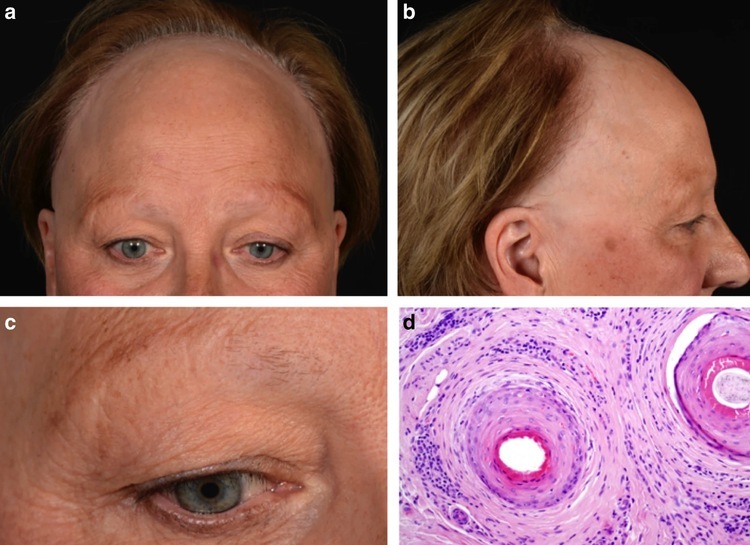Frontal Fibrosing Alopecia (FFA)

Frontal fibrosing alopecia (FFA) is a specific type of hair loss that primarily affects the frontal hairline and sides of the scalp. It can also cause hair loss in other body areas, such as the eyebrows, beard, arms, legs, and pubic area. FFA is more commonly diagnosed in women, particularly after menopause, but men can also be affected. This article aims to provide a comprehensive overview of FFA, including its symptoms, causes, diagnosis, treatment options, and self-care tips.
What is Frontal Fibrosing Alopecia?
Frontal fibrosing alopecia is a specific type of hair loss characterized by the destruction of hair follicles, leading to permanent hair loss. It typically presents as a receding hairline along the front and sides of the head, similar to a receding hairline seen in male pattern baldness. FFA can progress slowly over time or, in some cases, cause rapid hair loss. While no known cure exists, early diagnosis and appropriate treatment can help prevent further hair loss.
Causes of Frontal Fibrosing Alopecia:
The exact cause of frontal fibrosing alopecia remains unknown, but research suggests it may be an autoimmune condition. Autoimmune diseases occur when the immune system mistakenly attacks the body's tissues, in this case, the hair follicles. Factors such as genetics, hormonal imbalances, and inflammation may also contribute to the development of FFA. Although more research is needed, evidence suggests a potential link between FFA and other autoimmune diseases.
Symptoms and Diagnosis of Frontal Fibrosing Alopecia:
FFA often starts with a thin band of balding skin along the frontal hairline. As the condition progresses, individuals may experience hair loss in other areas, including the eyebrows, beard, arms, legs, and pubic region. Common symptoms include an itchy or painful scalp and a rash with small bumps. A dermatologist can diagnose FFA through a physical examination, evaluation of medical history, and, if necessary, a scalp biopsy to confirm the diagnosis.

Tziotzios, C., Petridis, C., Dand, N. et al., CC BY 4.0, via Wikimedia Commons
FFA Vs. CCA Vs. LPP: Comparing 3 common types of scarring alopecia
Frontal Fibrosing Alopecia (FFA), Cicatricial Centrifugal Alopecia (CCA), and Lichen Planopilaris (LLP) are three types of scarring alopecia. A biopsy is usually required for accurate differentiation. What are the clinical differences between these three conditions?

Treatment Options for Frontal Fibrosing Alopecia:
While FFA has no cure, various treatment options can help manage the condition and prevent further hair loss. Treatment plans are tailored to individual needs but often involve a combination of therapies. Medications such as finasteride or dutasteride may be prescribed to prevent further hair loss and promote limited hair regrowth. Corticosteroids, either injected or applied topically, can reduce inflammation and relieve symptoms. In some cases, hydroxychloroquine, laser therapy, and minoxidil may also be used.
In addition to the treatment options provided by dermatologists, there are alternative treatments that some individuals with frontal fibrosing alopecia (FFA) may consider. One such option is the use of MDhair treatment products, which are designed to stimulate blood flow in the scalp, counteract the effects of dihydrotestosterone (DHT) on hair follicles, and provide essential vitamins, minerals, and amino acids necessary for healthy hair growth. These products may include a topical solution containing minoxidil 2%, a treatment shampoo, and oral supplements aimed at promoting optimal results. Additionally, incorporating collagen peptides into your hair care routine may be beneficial. It is essential to consult with your dermatologist or healthcare provider before starting any alternative treatments to ensure their compatibility with your specific condition and overall treatment plan.
Self-Care Tips for Managing Frontal Fibrosing Alopecia:
- Avoid using chemical sunscreens and facial moisturizers containing gallates, fragrances, linalool, and avobenzone/oxybenzone, as there may be a link between these ingredients and the condition.
- Opt for mineral-based sunscreens, particularly those containing zinc oxide and titanium dioxide.
- Practice gentle scalp care and steer clear of tight hairstyles and the excessive use of heat from styling tools.
Frequently Asked Questions (FAQs):
1. Is frontal fibrosing alopecia contagious?
No, frontal fibrosing alopecia is not contagious. It is a non-communicable condition.
2. Is frontal fibrosing alopecia a rare condition?
When first identified in the 1990s, frontal fibrosing alopecia was considered rare. However, the number of diagnosed cases has been increasing rapidly over the years.
3. At what age does frontal fibrosing alopecia usually start?
Frontal fibrosing alopecia is typically diagnosed in women after menopause but can also occur earlier in life. In some cases, it has been observed in women who have not yet reached menopause.
4. How fast does frontal fibrosing alopecia progress?
FFA tends to develop slowly, but in some cases, it can cause rapid hair loss. The rate of progression varies among individuals.
5. Can frontal fibrosing alopecia be reversed?
If caught early and treated promptly, some hair regrowth may be possible. However, once the hair follicles have scarred, hair regrowth becomes challenging.
6. Can frontal fibrosing alopecia be stopped?
Early diagnosis and treatment can help prevent further hair loss and stabilize the condition. The effectiveness of treatment depends on individual factors and response to therapy.
7. Is stress a trigger for frontal fibrosing alopecia?
Stress may be a triggering factor for individuals predisposed to developing frontal fibrosing alopecia. However, more research is needed to establish a definitive link between stress and FFA.
8. Is frontal fibrosing alopecia genetic?
Evidence suggests a genetic component in the development of frontal fibrosing alopecia. It has been observed to run in families, indicating a possible hereditary factor.
9. What increases the risk of developing frontal fibrosing alopecia?
Factors that may increase the risk of developing FFA include menopause, having a close blood relative with FFA, and having certain medical conditions such as rosacea, thyroid disease, or type 2 diabetes.
10. Are there any dietary recommendations for frontal fibrosing alopecia?
There are no specific dietary recommendations for FFA. However, maintaining a balanced diet and overall good health can contribute to general well-being and potentially support hair health.
Conclusion:
Frontal fibrosing alopecia is a complex condition that requires early diagnosis and appropriate treatment to prevent further hair loss. While no known cure exists, various treatment options, including medications and therapies, can help manage FFA and stabilize the condition. Self-care strategies, such as gentle scalp care and joining a support group, can also aid in coping with the emotional impact of hair loss. If you suspect you have frontal fibrosing alopecia, it is crucial to consult a dermatologist for a proper diagnosis and personalized treatment plan.
References:
- Kanti V, Messenger A, Dobson K, et al. Frontal fibrosing alopecia: A review of its diagnosis and treatment. J Am Acad Dermatol. 2014;70(3):670-678.
- Samrao A, Chew AL, Price V. Frontal fibrosing alopecia: a clinical review of 36 patients. Br J Dermatol. 2010;163(6):1296-1300.
- Macpherson M, Ackerman C, Mutizwa M, et al. Frontal fibrosing alopecia in a man: case report and literature review. J Cutan Med Surg. 2013;17(2):122-126.
- Tziotzios C, Stefanato CM, Fenton DA, et al. Frontal fibrosing alopecia: reflections and hypotheses on etiology and pathogenesis. Exp Dermatol. 2016;25(7):477-481.
- Pirmez R, Duque-Estrada B, Donati A, et al. Frontal fibrosing alopecia in men: an association with facial moisturizers and sunscreens. Br J Dermatol. 2016;174(6):1307-1308.
- Moreno-Ramírez D, Camacho-Martínez F, Gómez-García FJ, et al. Frontal fibrosing alopecia: a multicenter review of 355 patients. J Am Acad Dermatol. 2014;70(4):670-678.
- Moreno-Arrones OM, Saceda-Corralo D, Fonda-Pascual P, et al. Frontal fibrosing alopecia: clinical and prognostic classification. J Eur Acad Dermatol Venereol. 2020;34(10):2242-2248.
- Vano-Galvan S, Molina-Ruiz AM, Serrano-Falcon C, et al. Frontal fibrosing alopecia: a multicenter review of 48 patients. J Am Acad Dermatol. 2014;70(4):670-678.
Find the most effective hair growth products for you by taking the free hair assessment.



